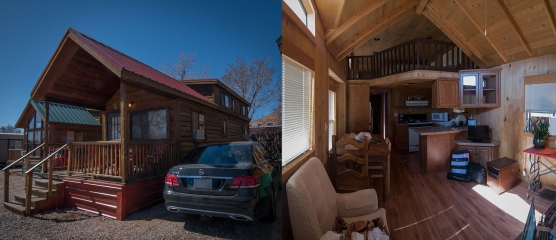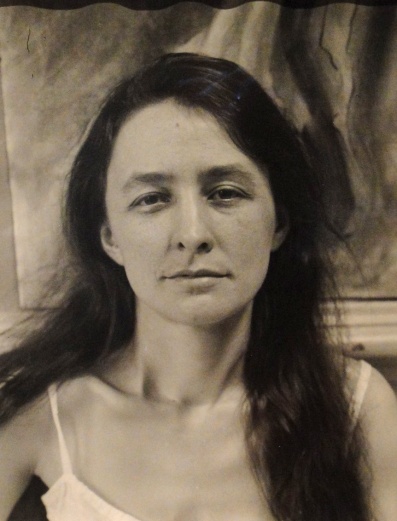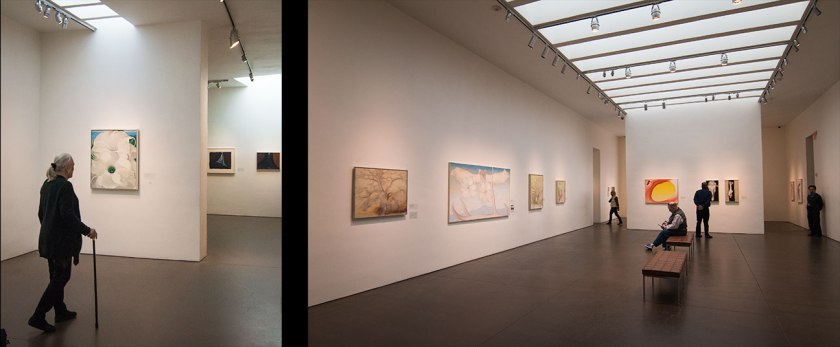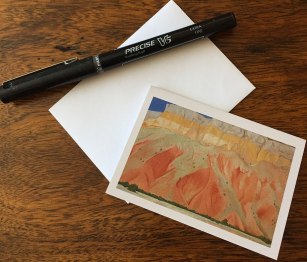
Each time I return to New Mexico, my affection for this state grows.
It really started on my second trip in 2009, when I visited Santa Fe and did many of the standard things one does around the square. Saw the Cathedral, had lunch, hit the Georgia O’Keeffe Museum.
During one long summer afternoon, I tucked into a coffee shop to get out of the noon-day heat and to do some writing. I was the only customer there, and before long, I was visiting with the barista who looked to be in his late thirties, a native American named De.
An old man swung in through the door.
“Hi, Doc. How’s the day?”
“Good enough, De. But I’m wanting some coffee.”
Doc looked like he came straight out of central casting. Film order: we need a quirky old man to play a part in a Coen brothers film set it Santa Fe.
Check. Enter Doc Murray.
Doc’s grey-and-white beard was lush and his eyebrows had a life of their own. He wore a neat chambray shirt and jeans. A wide leather bracelet on his left wrist was secured with three buckled straps, and he had heavy silver rings on his fingers. A fur hat-band and a tail adorned his felt hat. It may have been a fox’s tail. I don’t remember, and it doesn’t really matter anymore anyway.
He paused and tipped his hat to me. “Seems the neighborhood is improving.”
“We’ve been invaded,” De said. “She’s from Texas.”
I laughed, shook his hand, and introduced myself.
We passed a couple of hours talking about the state of the world, Texas, and New Mexico. About tourism and Santa Fe, and how the city had changed over Doc’s lifetime. About De, working as a barista to make some extra cash, and what he might do next, and about the difficulties that came along with being Native American.
Doc and I had another coffee, and De joined in. The two told me about the best route to drive to Taos, and talked about the high mountain meadows, and how pretty they’d be covered in grass flowers.
Near the end of our visit, Doc turned his head to look at someone passing on the street, and I saw the picture — his profile lit.
I have a hard time asking people to pose. But I did ask, and Doc, quite accommodating, looked at me and smiled. I have that picture, and it’s not bad. But then I asked him to turn just slightly towards the window and to hold very, very still.
So here is my Doc Murray. On a quiet afternoon in the heat of the summer, there was this moment, and I was honored to capture it.
By the end of the afternoon, Doc and De said I’d be welcome to move to Santa Fe anytime I wanted. And they wouldn’t even hold it against me that I was a Texan.
I found the wildflowers on my way to Taos.
Santa Fe, Again
I might have stayed in many places in Santa Fe. I chose to stay in a Tiny House in an RV park, right next to my good friend Joyce.
I’ve been to Santa Fe before and done the whole nice-hotel-near-the-square thing. For this trip, I looked at renting a casita near the square through VRBO — and there are some lovely ones . . . but in the end, I wanted to visit with my friend above anything else. Besides, I’ve been intrigued with the whole Tiny House movement, and I thought it would be fun.

Joyce and I cooked, visiting back and forth in our tiny houses. We tried new recipes out on one another. I rose early in my tiny house to write while she slept late in hers. Then we would convene for a museum visit or a ramble downtown, followed by a great meal. I love green chile sauce.
We spent two days on Museum Hill, exploring the Wheelwright Museum of the American Indian and the Museum of International Folk Art. Both of these museums were outstanding: great collections beautifully displayed. We had two meals at the Museum Hill Cafe that were outstanding — and what beautiful views across the valley towards the mountains!
What was I most excited about? Returning to the Georgia O’Keeffe museum.
I See You

“Art can die of overfamiliarity.” — Jay Tolson
What happens when we can no longer see a painting, because it has become as common as the McDonald’s logo?
In a 2005 article for U.S. News and World Report, Jay Tolson makes the point that O’Keeffe’s flowers and skulls are “images that have been ‘posterized’ to the point of invisibility.”
Humans filter out noise – both visual and aural. We have to — otherwise we’d be overwhelmed. O’Keeffe’s flowers and skulls, Monet’s bridge at Giverny, Leonardo da Vinci’s Mona Lisa . . . pick any over-reproduced work of art you’d like — all of them can turn into background wallpaper.
I was guilty of this with Georgia O’Keeffe’s work.
In an undergraduate class in 20th century American art, I had studied several of her paintings, but I didn’t know very much about her. Frankly, I wasn’t that interested.
I hadn’t looked closer – I’d just written her off.

My first visit to the Georgia O’Keeffe Museum changed my perception and understanding of the artist — and made me come into her work in a visceral and meaningful way I had not anticipated.
That first day in the O’Keeffe Museum, it was her abstract paintings that were the initial hook in for me. I simply and suddenly saw all of her work with new eyes, and I was excited.
I left the museum with Portrait of an Artist: A Biography of Georgia O’Keeffe, which I took to Taos and read for long hours. This book by Laurie Lisle is well-written and an easy read, and I found myself immersed in the stormy and passionate relationship between O’Keeffe and Stieglitz.
I realized that I had never really known Georgia O’Keeffe. And the woman I came to know, I like so very much.
I feel a kinship with her, with her passionate feelings about the big, western landscape of Ghost Ranch, seeing in it all of the feelings I’ve had out in Big Bend west Texas — a compulsion that drove me out to the big sky time and again over the last twenty-five years.
It was a great joy to return to the Georgia O’Keefe Museum, which is an intimate space, all simple white.
When it opened in 1997, the Georgia O’Keeffe Museum owned fewer than 100 works by the artist. In 2006, the Georgia O’Keeffe Foundation dissolved and transferred all of its artwork to the museum. The Georgia O’Keeffe Museum now owns 1,149 works by O’Keeffe, which represents more than half of her artistic output, as well as 1,840 works by other artists and photographers. Only a fraction of the collection is on display at any time.
Additionally, the museum owns both of her houses — the house at Abiquiu, and the house at Ghost Ranch. Visitors can see O’Keeffe’s house at Abiquiu, but only by reserving space on a limited number of tours. The house at Ghost Ranch is not currently open to the public, but will be at some point in the future. Those wanting to see the house at Abiquiu MUST plan ahead; go to Georgia O’Keeffe Museum Tickets and Tours to read about the three different options.


Finding Ghost Ranch
We took a day trip to Ghost Ranch, and I got my foot caught in the door — I had arrived at one of those unexpected places that just blew me away and that I didn’t want to leave.
When we dropped down from the plateau at Abiquiu, the Pedernal lay to my left, quiet and blue. An orange, yellow, and purple rockscape stretched in front of me. Before we reached the gravel road for the ranch, the road turned us through towering red rock cliffs.
It caught my breath. My heart expanded and I thought I might cry.
When we stopped at the Visitor’s Center at Ghost Ranch, I immediately booked a room for later in the week. Before we left, I stopped again and asked if I could stay two nights instead of just one.

At the end of my two days, I was not ready to leave, but the clock was ticking.
I had reached my furthest point out, that point where you can go no further, stay no longer, and still make it back in time. In time for whatever holds you.
All road trips have those points.
With Ghost Ranch in my rearview mirror, I began my way back, then stopped in the post office in Abiquiu and sent a tiny O’Keeffe to a friend.
Ghost Ranch is an Education and Retreat Center that has been owned by the Presbyterian Church for over 55 years. They offer many different kinds of workshops and retreats, but visitors can also simply book a room. There are two museums, trail riding, hiking trails, and guided tours — one of my favorites being a tour through many of the landscapes Georgia O’Keeffe painted.
My return is already planned. I go back to Ghost Ranch in seven days, and yes, I will share that visit with you in my third article on New Mexico, focused on Ghost Ranch.
Embracing Santa Fe is the second in a series of three posts on New Mexico.
The first is Road Trip to New Mexico:
And you’ll find the third part in the series here:

Thank you for visiting!
I’m writing and traveling full-time now, and if you like my work, please subscribe to my blog via email.




























